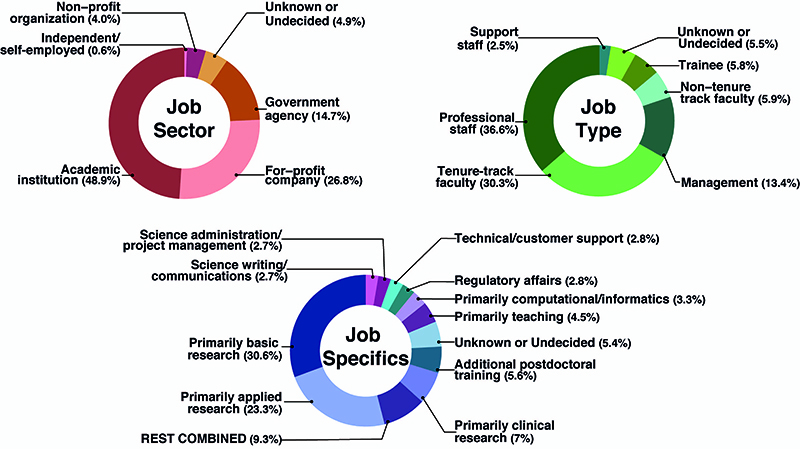New Methods
Making Informed Career Decisions
New Tool Helps NIH Postdocs Visualize Employment Trends
Scientists looking for jobs after completing their training may soon have a new tool that helps them evaluate various career paths. Developed by a team led by Tammy Collins (National Institute of Environmental Health Sciences), the tool uses a method that differs from others in that it creates a standard career-outcome taxonomy that classifies careers in the biomedical sciences by sector, type, and job specifics. Until now, the lack of standardized measures has made it difficult for postdocs to make informed decisions about their career prospects. The creators hope this novel approach will be useful throughout NIH as well as for academic and research institutions around the world.

CREDIT: NATURE BIOTECHNOLOGY
The NIEHS study categorized career outcomes for NIEHS postdocs by sector, type, and job specifics. The authors envision that this approach will help young scientists make career decisions based on data and not anecdotal evidence.
Team members collected detailed career outcomes—by searching through PubMed, social media, alumni websites, Google, Board of Scientific Counselors reviews, and more—for some 900 NIEHS postdoctoral fellows over the past 15 years. Lead author and NIEHS computer scientist Hong Xu analyzed the data using the R Project for Statistical Computing, a free online program that displays data using graphs and charts. The study appeared earlier this year in the journal Nature Biotechnology and is the first standardized method for categorizing career outcomes of NIEHS postdocs (Nat Biotechnol 36:197–202, 2018; DOI:10.1038/nbt.4059).
“As we sought to determine how to make sense of detailed career outcomes in a standardized way, we used a bottom-up approach, rather than forcing the data into any particular naming system already being employed,” said Collins, who is the director of the NIEHS Office of Fellows’ Career Development. “We looked at what our postdocs were specifically doing, and asked what is the most logical way to categorize and visualize the information.”
The careers project began in 2013 as a way to establish a snapshot of career trajectories for NIEHS postdocs and to report the findings to NIH. The researchers found distinct differences between domestic and international NIEHS postdocs in the kinds of jobs they landed. About half of the postdocs were from the United States and half were from other countries. U.S. postdocs were more likely than their international counterparts to enter for-profit companies to do applied research.
In contrast, international postdocs were almost twice as likely as their U.S. peers to enter academic tenure-track positions and do basic research. Notably, 70 percent of those academic positions were outside the United States. Overall, nearly half of all NIEHS postdocs went into the academic sector, which was surprising to some, because many young scientists thought that doing a government postdoctoral fellowship might hinder their chances of getting a tenure-track position in academia.
“We hope that the taxonomy, definitions, and visualization methods presented will eliminate a key hurdle in career outcome reporting and analysis—inspiring others to use our methodology so that more finely tuned, meaningful, institution-level information will be available for cross-comparisons within the global scientific research community,” the authors wrote in their paper. “Having this institution-level information will allow prospective and current doctoral candidates to evaluate their career prospects based on real data, rather than anecdotes. Likewise, this information will allow institutions to critically evaluate the effectiveness of their programs, so that data-driven decisions can be made to provide programming that supports student transitions into the modern career environment.”
The career outcomes tool was presented to the scientific directors, this spring, to promote trans-NIH adoption. For more information, go to https://www.niehs.nih.gov/careers/research/fellows/alumni-outcomes/index.cfm or contact Tammy Collins (984-287-3651 or tammy.collins@nih.gov).
This page was last updated on Wednesday, April 6, 2022
